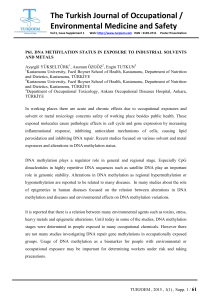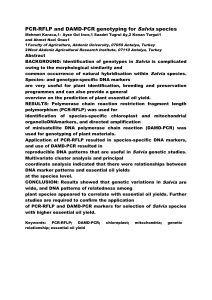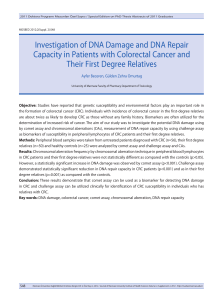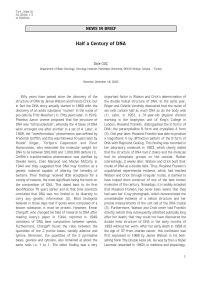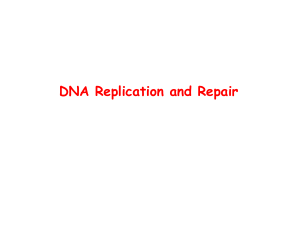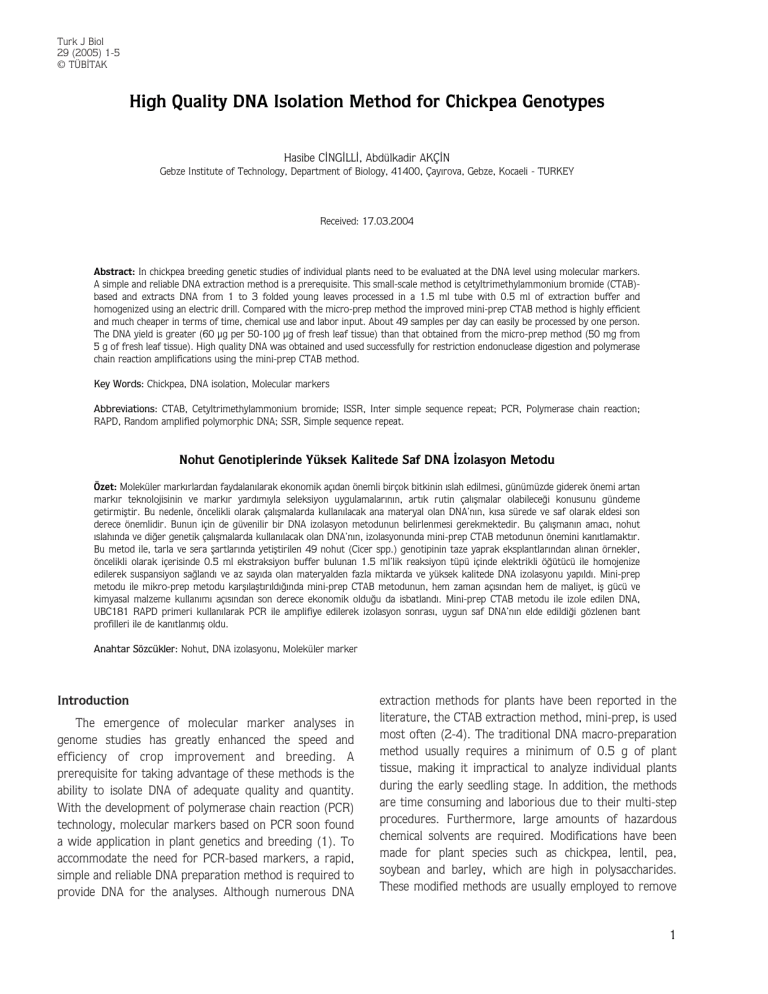
Turk J Biol
29 (2005) 1-5
© TÜB‹TAK
High Quality DNA Isolation Method for Chickpea Genotypes
Hasibe C‹NG‹LL‹, Abdülkadir AKÇ‹N
Gebze Institute of Technology, Department of Biology, 41400, Çay›rova, Gebze, Kocaeli - TURKEY
Received: 17.03.2004
Abstract: In chickpea breeding genetic studies of individual plants need to be evaluated at the DNA level using molecular markers.
A simple and reliable DNA extraction method is a prerequisite. This small-scale method is cetyltrimethylammonium bromide (CTAB)based and extracts DNA from 1 to 3 folded young leaves processed in a 1.5 ml tube with 0.5 ml of extraction buffer and
homogenized using an electric drill. Compared with the micro-prep method the improved mini-prep CTAB method is highly efficient
and much cheaper in terms of time, chemical use and labor input. About 49 samples per day can easily be processed by one person.
The DNA yield is greater (60 µg per 50-100 µg of fresh leaf tissue) than that obtained from the micro-prep method (50 mg from
5 g of fresh leaf tissue). High quality DNA was obtained and used successfully for restriction endonuclease digestion and polymerase
chain reaction amplifications using the mini-prep CTAB method.
Key Words: Chickpea, DNA isolation, Molecular markers
Abbreviations: CTAB, Cetyltrimethylammonium bromide; ISSR, Inter simple sequence repeat; PCR, Polymerase chain reaction;
RAPD, Random amplified polymorphic DNA; SSR, Simple sequence repeat.
Nohut Genotiplerinde Yüksek Kalitede Saf DNA ‹zolasyon Metodu
Özet: Moleküler mark›rlardan faydalan›larak ekonomik aç›dan önemli birçok bitkinin ›slah edilmesi, günümüzde giderek önemi artan
mark›r teknolojisinin ve mark›r yard›m›yla seleksiyon uygulamalar›n›n, art›k rutin çal›flmalar olabilece¤i konusunu gündeme
getirmifltir. Bu nedenle, öncelikli olarak çal›flmalarda kullan›lacak ana materyal olan DNA’n›n, k›sa sürede ve saf olarak eldesi son
derece önemlidir. Bunun için de güvenilir bir DNA izolasyon metodunun belirlenmesi gerekmektedir. Bu çal›flman›n amac›, nohut
›slah›nda ve di¤er genetik çal›flmalarda kullan›lacak olan DNA’n›n, izolasyonunda mini-prep CTAB metodunun önemini kan›tlamakt›r.
Bu metod ile, tarla ve sera flartlar›nda yetifltirilen 49 nohut (Cicer spp.) genotipinin taze yaprak eksplantlar›ndan al›nan örnekler,
öncelikli olarak içerisinde 0.5 ml ekstraksiyon buffer bulunan 1.5 ml’lik reaksiyon tüpü içinde elektrikli ö¤ütücü ile homojenize
edilerek suspansiyon sa¤land› ve az say›da olan materyalden fazla miktarda ve yüksek kalitede DNA izolasyonu yap›ld›. Mini-prep
metodu ile mikro-prep metodu karfl›laflt›r›ld›¤›nda mini-prep CTAB metodunun, hem zaman aç›s›ndan hem de maliyet, ifl gücü ve
kimyasal malzeme kullan›m› aç›s›ndan son derece ekonomik oldu¤u da isbatland›. Mini-prep CTAB metodu ile izole edilen DNA,
UBC181 RAPD primeri kullan›larak PCR ile amplifiye edilerek izolasyon sonras›, uygun saf DNA’n›n elde edildi¤i gözlenen bant
profilleri ile de kan›tlanm›fl oldu.
Anahtar Sözcükler: Nohut, DNA izolasyonu, Moleküler marker
Introduction
The emergence of molecular marker analyses in
genome studies has greatly enhanced the speed and
efficiency of crop improvement and breeding. A
prerequisite for taking advantage of these methods is the
ability to isolate DNA of adequate quality and quantity.
With the development of polymerase chain reaction (PCR)
technology, molecular markers based on PCR soon found
a wide application in plant genetics and breeding (1). To
accommodate the need for PCR-based markers, a rapid,
simple and reliable DNA preparation method is required to
provide DNA for the analyses. Although numerous DNA
extraction methods for plants have been reported in the
literature, the CTAB extraction method, mini-prep, is used
most often (2-4). The traditional DNA macro-preparation
method usually requires a minimum of 0.5 g of plant
tissue, making it impractical to analyze individual plants
during the early seedling stage. In addition, the methods
are time consuming and laborious due to their multi-step
procedures. Furthermore, large amounts of hazardous
chemical solvents are required. Modifications have been
made for plant species such as chickpea, lentil, pea,
soybean and barley, which are high in polysaccharides.
These modified methods are usually employed to remove
1
High Quality DNA Isolation Method for Chickpea Genotypes
polysaccharides (5). b-mercaptoethanol was found to
improve extracted DNA quality (6). For PCR-based DNA
markers used in marker-assisted selection a fast DNA
extraction method is needed. In recent years, significant
progress has been made in the use of molecular marker
technology for plant breeding. In addition to their use in
plant breeding, molecular markers offer specific
advantages in genome mapping, DNA fingerprinting and
the study of genetic diversity. PCR-based molecular
markers (RAPDs, ISSRs, STMSs etc.) are preferred to
hybridization markers like RFLPs for marker-assisted
selection because they permit the breeder to use smaller
amounts of more crudely prepared DNA from each plant
being genotyped, thus reducing the time, labour and
operational costs of DNA extraction (7). Molecular markers
closely linked to numerous traits of economic importance
have been developed in several crop plants (8) and will
allow indirect selection for desirable traits in genotypes.
Indirect selection is very effective because of the absence
of a confounding effect of the environment, and also
allows pyramiding of genes for characteristics, which is
difficult to achieve through the use of conventional
methods of plant breeding (9). Mini-prep methods require
only a small amount of tissue, and use minimal numbers
and amounts of chemicals. Furthermore, by this method is
high-quality DNA in large quantities are extracted. Many
mini-prep methods for obtaining DNA have been
developed, including such modifications as no grinding and
no centrifugation (10). To show the success of the
presented CTAB mini-prep method, DNA samples were
isolated from 49 chickpea genotypes by purification
through a CsCl ethidium bromide gradient and the
described mini-prep procedure. The DNA isolated by this
CTAB mini-prep method compared favorably to the control
CsCl cleaned DNA for use in RAPD reactions (11).
The present study reports a rapid, simple, reliable and
inexpensive method for isolating DNA from chickpea
genotypes, yielding DNA in a quantity and quality suitable
for DNA marker analysis.
Materials and Methods
Plant materials
We successfully experimented with mature leaves of
field and greenhouse grown plants (Table). However, for
breeding applications, leaf tissue is preferred because its
collection is the least destructive. Fresh leaf tissue was
2
collected and placed on ice. Tissue can be used
immediately or stored at -80 oC. Freeze-dried tissue can
be used, but is not recommended because DNA yields are
reduced. Fresh tissue (1 g) was used for the isolation.
The tissue was frozen in liquid nitrogen and ground in a
mortar and pestle. The ground tissue was subsequently
suspended in 0.25 M sucrose, 0.03 M Tris and 0.05 M
EDTA. The homogenate was then centrifuged at 500xg
(2200 rpm) for 15 min.
DNA Extractions
Micro-prep method: Fresh tissue samples (growing
buds) were collected into labeled 1.5 ml microfuge tubes
and then mixed with 1.5 ml of extraction buffer per
sample [0.1 M Tris-HCl, pH 8.0; 1.0 M NaCl; 0.02 M
EDTA, pH 8.0; 2% (w/v) CTAB; 2% (w/v)
polyvinlypyrrolidone-40; 0.4% β-mercaptoethanol] and
o
incubated for 1 h at 65 C. The solution was then twice
extracted with equal volumes of chloroform:isoamyl
alcohol (24:1) and centrifuged at 12, 000 x g at 4 oC for
10 min. The aqueous phase was transferred to a fresh
tube, and the DNA was precipitated with an equal volume
of cold ethanol and kept at -20 oC overnight. The DNA
was then spooled out and washed with 75% ethanol for
20 min with gentle shaking. The DNA pellet was air dried
and dissolved in 5 ml of sterile TE buffer (Tris-EDTA
buffer) by incubation at 60 oC for 20 min. The DNA was
then subjected to an additional cleaning procedure. The
cleaned DNA pellet was resuspended in Tris-EDTA buffer
containing 1 µl of RNase (10 mg/ml)/100 µl of TE.
Mini-prep method: A g tissue sample was removed
from the -70 oC ultracold freezer and placed on dry ice. The
sample was immersed in liquid nitrogen and ground to a fine
powder with a mortar and pestle, and the ground powder
was transferred to a 50 ml corning tube containing 7.5 ml
of ice cold extraction buffer. The tube was then capped and
briefly shaken. To the tubes were added 7.5 ml of nuclei
lysis buffer and 3 ml of 5% sarkosyl. After incubation at 65
o
C for 20 min to 2 h, 18 ml of chloroform:isoamyl alcohol
(24:1) was added and the tube was centrifuged at 500 x g
and 4 oC for 15 min. The supernatant was transferred to a
fresh tube and mixed with 15 ml of chloroform:isoamyl
alcohol solution. After sequential washing with 75% and
95% ethanol, the DNA pellet was air dried and suspended in
5 ml of TE buffer, to which was added 5 µl of RNase. The
DNA yield and quality were estimated by absorbance spectra
at 260 nm. Genomic DNA was then electrophoresed on 1%
and 1.4% agarose gels.
H. C‹NG‹LL‹, A. AKÇ‹N
Table Chickpea genotypes used in DNA isolation reactions.
S. No
Species
Accession
Description
Origin
1
2
3
4
5
6
7
8
9
10
11
12
13
14
15
16
17
18
19
20
21
22
23
24
25
26
27
28
29
30
31
32
33
34
35
36
37
38
39
40
41
42
43
44
45
46
47
48
49
C. arietinum
C. arietinum
C. arietinum
C. arietinum
C. arietinum
C. arietinum
C. arietinum
C. arietinum
C. arietinum
C. arietinum
C. arietinum
C. arietinum
C. arietinum
C. arietinum
C. arietinum
C. arietinum
C. arietinum
C. arietinum
C. arietinum
C. arietinum
C. arietinum
C. arietinum
C. arietinum
C. arietinum
C. arietinum
C. arietinum
C. arietinum
C. arietinum
C. arietinum
C. arietinum
C. arietinum
C. arietinum
C. arietinum
C. arietinum
C. arietinum
C. arietinum
C. arietinum
C. arietinum
C. arietinum
C. arietinum
C. arietinum
C. arietinum
C. arietinum
C. arietinum
C. arietinum
C. arietinum
C. arietinum
C. arietinum
C. reticulatum
AKN33
AKN42
AKN98
AKN99
AKN102
AKN144
AKN145
AKN146
AKN147
AKN148
AKN395
AKN411
AKN426
AKN568
87AK71114
ESER87
‹ZM‹R92
MENEMEN
DAMLA89
GÖKÇE
KÜSMEN99
ER99
UZUNLU99
AKÇ‹N91
SARI98
AYDIN92
AZ‹Z‹YE94
AKN26
AKN63
AKN78
AKN79
AKN88
AKN89
AKN564
AKN566
AKN567
AKN570
AKN587
AKN589
AKN591
AKN592
AKN599
ESKVD17
ESKVD18
ESKVD45
CANITEZ
KIRMIZI NOHUT
FLIP 84-92C(3)
PI 599072
resistant to Ascochyta blight
resistant to Ascochyta blight
resistant to Ascochyta blight
resistant to Ascochyta blight
resistant to Ascochyta blight
resistant to Ascochyta blight
resistant to Ascochyta blight
resistant to Ascochyta blight
resistant to Ascochyta blight
resistant to Ascochyta blight
resistant to Ascochyta blight
resistant to Ascochyta blight
resistant to Ascochyta blight
resistant to Ascochyta blight
resistant to Ascochyta blight
resistant to Ascochyta blight
resistant to Ascochyta blight
resistant to Ascochyta blight
resistant to Ascochyta blight
resistant to Ascochyta blight
resistant to Ascochyta blight
resistant to Ascochyta blight
resistant to Ascochyta blight
resistant to Ascochyta blight
resistant to Ascochyta blight
resistant to Ascochyta blight
resistant to Ascochyta blight
susceptible to Ascochyta blight
susceptible to Ascochyta blight
susceptible to Ascochyta blight
susceptible to Ascochyta blight
susceptible to Ascochyta blight
susceptible to Ascochyta blight
susceptible to Ascochyta blight
susceptible to Ascochyta blight
susceptible to Ascochyta blight
susceptible to Ascochyta blight
susceptible to Ascochyta blight
susceptible to Ascochyta blight
susceptible to Ascochyta blight
susceptible to Ascochyta blight
susceptible to Ascochyta blight
susceptible to Ascochyta blight
susceptible to Ascochyta blight
susceptible to Ascochyta blight
susceptible to Ascochyta blight
susceptible to Ascochyta blight
resistant to Ascochyta blight
susceptible to Ascochyta blight
CIFC
CIFC
CIFC
CIFC
CIFC
CIFC
CIFC
CIFC
CIFC
CIFC
CIFC
CIFC
CIFC
CIFC
AARI
AARI
AARI
AARI
AARI
AARI
AARI
AARI
AARI
AARI
AARI
AARI
AARI
AARI
AARI
CIFC
CIFC
CIFC
CIFC
CIFC
CIFC
CIFC
CIFC
CIFC
CIFC
CIFC
CIFC
CIFC
AARI
AARI
AARI
AARI
AARI
WSU
WSU
Anadolu Agricultural Research Institute (AARI), Eskiflehir, Turkey,
Central Institute for Field Crops (CIFC), Ankara, Turkey,
Washington State University (WSU), Pullman
3
High Quality DNA Isolation Method for Chickpea Genotypes
PCR Analysis
PCR amplifications were performed in 10 mM TrisHCl, pH 8.0; 50 mM KCl; 0.1% (v/v) Triton X-100; 1.5
mM MgCl2; 100 µM dNTP; 0.24 µM primer; 20 ng of
DNA and 1 unit of Taq DNA polymerase per 25 µl reaction
using RAPD primer (UBC181-ATGACGACGG) (Invitrogen,
England). RAPD reactions were performed with the
following cycle repeated 40 times: denaturing at 94 oC
for 20 s, annealing at 36 oC for 1 min with a ramp to 72
o
C and elongation at 72 oC for 1 min. The final elongation
segment was held for 8 min. PCRs were carried out in a
PTC-100 thermocyler (MJ Research, USA). The
amplification products were resolved by electrophoresis
in 2% agarose gels. The bands were visualized using
ethidium bromide staining.
Results
Genomic DNA from chickpea cultivars, breeding lines
and parents was isolated using the mini-prep and microprep methods. In the mini-prep method, the yield
averaged 150 µg of DNA/1 g of leaf tissue. DNA samples
isolated using this method were amenable to PCR
amplifications, and were used to initiate RAPD marker
studies of chickpea genotypes (Figure). RAPD analysis
Figure. Single primer (UBC181) PCR amplification of mini-prep DNA
from chickpea genotypes. Lane 1: M. Marker, pBR322BstN1
digest, Lane 2: FLIP84-92C(3), Lane 3: PI599072 (Cicer
reticulatum L.), Lane 4: Akçin91, Lane 5: Landrace -Kırmızı
Nohut (Cicer arietinum L.).
4
employing 10 other base primers gave equivalent results
for the methods of DNA preparation. A CTAB-based miniprep method for DNA extraction process is undertaken in
1.5 ml tubes with 0.5 ml of the respective solutions. The
DNA is separated by centrifugation. Furthermore, very
high DNA yield and quality that can be used for PCR
analysis are obtained. We describe a simple and efficient
method for genomic DNA extraction from chickpea
genotypes. Recently, the procedure was used to isolate
DNA from samples of hundreds of accessions.
Discussion
The CTAB mini-prep method is rapid and yields DNA
sufficiently pure for RAPD fingerprints. RAPD markers
are generated by PCR amplification of random genomic
DNA segments with single primers in an arbitrary
sequence (12). They are usually dominant markers with
polymorphisms between individuals defined as the
presence or absence of a particular RAPD band (13). In
performing population studies using RAPD, the time
consuming step is often isolating DNA from numerous
samples. For researchers using amplification techniques
on hundreds of plant DNA samples, large yields are likely
to be less important than speed and cost of sample
preparation. This procedure, with minor modifications in
equipment, may useful for DNA extractions in the field,
and it can be directly applied to many different plants.
Various approaches and protocols were developed to
address the problem (for example, 3, 12, 14-16). The
advantage of our mini-prep method is that leaf samples
can be collected at any time during the growing season,
as long as leaf buds are available, even in the late season
when plants are infested with diseases. Originally, an
initial mini-prep method was introduced and used to
prepare soybean DNA directly from leaf disks for SSR
analysis without DNA quantification. We successfully used
DNA extracted by this method for RAPD analysis of
isolated genes responsible for resistance. All the DNA
templates produced clear, sharp and reproducible PCR
banding patterns. Our method is comparable to
conventional plant DNA isolation methods in terms of the
speed of isolation, requiring 3-4 h from the fresh tissue
up to the final DNA resuspension. We have found that this
method generates DNA that yields more reproducible
results in the RAPD system than does DNA generated by
other isolation methods.
H. C‹NG‹LL‹, A. AKÇ‹N
Acknowledgments
Corresponding author:
This work was supported by the Research Foundation
of the Gebze Institute of Technology. We would like to
thank Dr. Mücella Tekeo¤lu (Agriculture Research
Institute, Eskiflehir-Turkey) for allowing the first author
to perform molecular experiments in her laboratory, and
we also thank Dr. Ömür Can and Funda Akfırat for their
helpful suggestions during this study.
Hasibe C‹NG‹LL‹
Türbe Caddesi,
Pürçüklü Mahallesi, No: 45,
42040-01, Karatay, Konya - TURKEY
e-mail: [email protected]
References
10.
Dellaporta SL, Wood J, Hicks JB. A plant DNA mini-preparation:
version 2, Plant Mol Biol Report 1: 19-22, 1983.
Zhang J, Stewart J.McD. Economical and rapid method for
extracting cotton genomic DNA. The Journal of Cotton Science 4:
193-201, 2000.
11.
Do N, Adams RP. A simple technique for removing plant
polysaccharide contaminants from DNA. BioTechniques. 10: 162166. 1991.
Deragon JM, Landry BS. RAPD and other PCR-based analyses of
plant genomes using DNA extracted from small leaf disks. PCR
Methods Appl 1: 175-180, 1992.
12.
Maniatis T, Fritsch EF, Sambrook J. Molecular Cloning: A
Laboratory Manual. Cold Springs Harbor Laboratory, Cold
Springs Harbor, NY, pp.3-E.4. 1982.
Williams JGK, Kublelik, AR, Livak KJ et al. DNA polymorphisms
amplified by arbitrary primers are useful as genetic markers.
Nucleic Acids Res. 18: 6531-6535, 1990.
13.
5.
Lodhi MA, Ye GN, Weeden NF et al. A simple and efficient method
for DNA extraction from grapevine cultivars and Vitis species.
Plant Mol Biol Report 12: 6-13. 1994.
Staub JE, Serquen FC, Gupta M. Genetic markers map
construction and their application in plant breeding. Hort Science
31: 729-741,1996.
14.
6.
Paterson AH, Brubaker CL, Wendel JF. A rapid method for
extraction of cotton (Gossypium spp.) genomic DNA suitable for
RFLP and PCR analysis. Plant Mol Biol Report 11: 122-127.
1993.
Manning K. Isolation of nucleic acids from plants by differential
solvent precipitation. Anal Biochem. 195: 45-50, 1991.
15.
Fang G, Hammer S, Grumet R. A quick and in expensive method
for removing polysaccharides from plant genomic DNA.
BioTechniques 13(1) : 52-56, 1992.
16.
Zhu H, Feng Q, Zhu LH. Isolation of genomic DNA from plants,
fungi, and bacteria using benzyl chloride. Nucleic Acids Res.
21(22) : 5279-5280, 1993.
1.
Lee M. DNA markers and plant breeding programs. Adv Agron
55: 265-344, 1995.
2.
3.
4.
7.
Sant VJ, Patankar AG, Sarode ND et al. Potential of DNA markers
in detecting divergence and in analyzing heterosis in Indian elite
chickpea cultivars, Theor Appl Genet 98: 1217-1225, 1999.
8.
Caetano-Anollés G, Greshoff PM. DNA markers: Protocols,
applications and overviews. Wiley-Liss, John Wiley & Sons, New
York, 1997.
9.
Gupta PK, Varshney RK. The development and use of
microsatellite markers for genetic analysis and plant breeding
with emphasis on bread wheat. Euphytica 113: 163-185, 2000.
5







